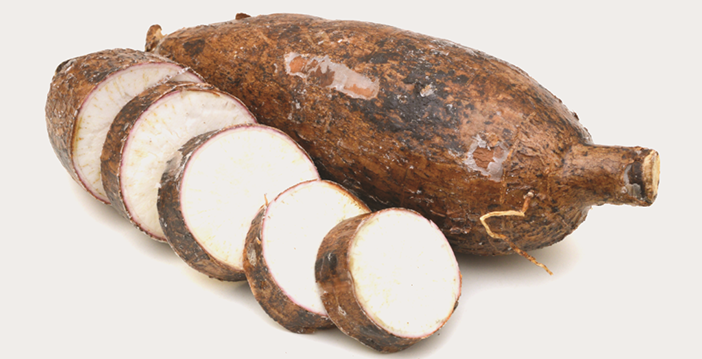It's been hot and steamy here in Vermont for the past few weeks, so when we had a few friends over for dinner recently, I...
Read MorePaleo Spicy Yuca Fries
In each issue of Paleo Magazine, I team up with Steph Gaudreau to share the history of a traditional recipe and adapt it to fit into a healthier paleo lifestyle. (I write the words; she makes the gorgeous photos.) In this recipe, we got into a starchy, irresistible taste of Latin America: yuca.
This might be an unpopular opinion, but we’re going to take a stand: In the battle of fried starchy things (Is this a battle that actually exists? Who knows? Just play along!), yuca frita is the champion. You can have your french fries and onion rings; we’ll take the crispy cassava.
Before we delve into the history of this irresistible root vegetable, a vocabulary explanation. Yuca is pronounced YOO-ka and has many other names, including cassava, manioc, mandioca, casabe, and tapioca. It should not be confused with yucca (pronounced YUCK-ah), an ornamental plant you might have in a rock garden in your yard (although you might see yuca misspelled on restaurant menus and online recipes because translation can be inconsistent).
The edible yuca is usually about six to 10 inches long and three inches in diameter. Covered in brown, bark-like skin, it resembles a miniaturized baseball bat. Inside, it’s chalky in both color and texture when raw, but turns meltingly tender and translucent after it’s cooked. Because the flesh bruises easily, it’s usually coated in wax when sold in the U.S., and you’ll find it in the produce section of the grocery store amid the other tropical imports like plantain, mango, and papaya.
Yuca is fairly new to American cooks, but in Latin America, Africa, and parts of Asia, families have been eating the starchy flesh of the yuca for centuries. The earliest direct evidence of yuca cultivation dates back 1400 years to a Mayan settlement in El Salvador. By the time the Spanish Conquistadors washed up on the shores of South America, Mesoamerica, and the Caribbean in the 16th century, yuca was a staple food for native populations. The root is poisonous when eaten raw; according to lore, some of the natives took their own lives by eating raw cassava, rather than submit to becoming Spanish colonial citizens.
Yuca made its way across the Atlantic on Spanish ships that sailed to Europe and with Portugese traders bound for Africa. This culinary migration established Latin American crops like maize and yuca in the African diet. Yuca is now a primary staple food across the developing world. Although the root is native to Brazil, the world’s largest producer is now Nigeria. It’s also grown all over Latin American, the Caribbean, Asia, and other African countries.
Yuca has several advantages over other starchy staple crops. It’s tolerant of poor soil, grows with minimal rainfall, and allows for a wide harvesting window. It also provides essential nutrients along with energy-dense calories.
Loaded with Vitamin C, one cup of yuca provides more than 70% of the daily requirement, along with thiamin, folate, potassium, magnesium, and manganese. It’s also an excellent anti-inflammatory and contains muscle-soothing compounds called saponins. Yuca delivers a big dose of resistant starch when cooked, cooled, and reheated—which makes yuca fries an ideal food for modern Paleo eaters.
Which brings us to the truly fun facts about yuca: all the ways it can be eaten! Since ancient times, cooks have been turning cassava into a naturally grain-free flour to make empanadas, chips, fritters, tamales, and breads. In its whole state, it can be boiled and then buttered, roasted, mashed, fried, or—as you’ll see in our recipe—roasted to crispy perfection.
The yuca root can be a little unwieldy at first, but once it’s peeled, it feels a lot like a potato. When buying yuca, look for firm roots without soft spots, and always buy more than you think you need because once it’s peeled, you might find some flaws inside. The peeled flesh should be pure white; if it has dark streaks running through it, it’s past its prime. Just cut the darkened section away and carry on.
To prep the yuca, cut the root cross-wise into pieces that feel manageable, then use a paring knife or vegetable peeler to remove the outer bark. Once it’s peeled, you can easily cut it into your preferred shape and get cookin’.
One of the tastiest ways to luxuriate in the tender, starchy texture of yuca is with fries. But even with healthy oils, deep-frying can mean too much of a good thing. With this recipe, we boil the yuca first to coax out its softer side and create surface cracks to maximize crunch later. The fries are then tossed with fat and spices, and the oven does the work of making them crisp. This technique yields fries with a snappy exterior and creamy, dense interior.
These fries taste great just as they are, but they’re also awesome with Garlic Sauce or Lizard Sauce, if you prefer to dip. They’re pretty terrific with your favorite guacamole recipe, too.
Spicy Yuca Fries
Serves 4 | Prep 30 minutes | Cook 30 minutes | Whole30 compliant
Recipe by me; awesome photo by Steph Gaudreau
Note: You can often find peeled yuca in frozen food section of the grocery store; this will do in a pinch. And if you’re using fresh yuca, you can peel and boil it, then store in the fridge (or freezer) until you’re ready to toast it in the oven.
Ingredients:
2 pounds fresh yuca
1 tablespoon salt
2 tablespoons extra-virgin olive oil, lard, tallow, duck fat, or coconut oil
1/2 teaspoon salt
1/4 teaspoon paprika
1/4 teaspoon cayenne pepper
zest from 1 lime
Directions:
Preheat oven to 450F and cover a large baking sheet with parchment paper.
Peel yuca with a vegetable peeler to remove the waxy skin. Cut in half crosswise to make it easier to manage, then slice in half length-wise. Cut into 1/4-inch thick fry strips.
Place fries in a large pot, cover with cold water, and add the salt. Bring to a boil and cook 10-15 minutes, or until tender. Drain fries and place in a large bowl. Toss with fat until coated, then spread in a single layer on the baking sheet.
Roast 10-15 minutes, until beginning to brown, then flip and roast an additional 10-15 minutes. When they’re crisped the way you like them, remove from oven and sprinkle with spices and lime zest. Serve immediately.
For more delicious recipes like this one, subscribe to Paleo Magazine.
Still hungry? Try these
Once upon a time, we took a spur-of-the-moment trip to Costa Rica, thinking it would be a big adventure. For a variety of reasons, it...
Read More






If using frozen yuca, do you still need to boil before baking?
Probably not. Once it’s defrosted, you can probably go straight to the baking step—but read the package. It should tell you if you have to pre-boil before roasting.
Great recipe. Kids would surely love this and kids at heart.